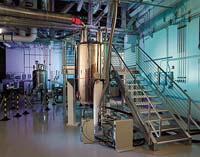Magnetic resonance imaging without magnetism

It seems a contradiction, but experts explain a new chemical analysis technique created by a large group of American researchers: nuclear magnetic resonance without magnetism. They want to emphasize that this is an adaptation of conventional nuclear magnetic resonance, in which the sample to be analyzed should not be included in a magnetic field, but the basic principle and the result obtained are equal to conventional magnetic resonance. The new technique has been published in the journal Nature Physics.
The advantage of not using magnetism is that the size of the equipment can be small. In conventional technique, the accuracy of the analysis increases with the magnetic field used; the most accurate analyses require a giant electromagnet of superconducting material that generates a very large field and therefore works at very low temperatures at the temperature of liquid helium. Equipment without magnetic fields can be small and portable.
But to be able to remove the magnetic field you have to add something else. In conventional technique, the magnetic field is only a component that aligns the magnetic spines of the nuclei of some atoms of the sample, but the real analysis is due to the radiations of the radio waves: among the spines of the nuclei there is a small magnetic interaction (called coupling J) that responds differently to the irradiation of the radio waves according to the other atoms that surround the atom. Hence, this technique serves to perform a chemical analysis: it indicates the other atom to which an atom is surrounded.
The purpose of the large magnetic field is to amplify the J coupling. The American team has sought a new way to amplify. And they have discovered it using the parahydrogen molecule, a hydrogen molecule with spines from the nuclei of both atoms in the opposite direction. This molecule induces a large magnetic coupling to the sample to be analyzed, without having to enter another field. Parahydrogen has been used by other researchers, but this American team has achieved the first nuclear resonance without having to add a small outer magnetic field. Portable nuclear resonance equipment is on track.





